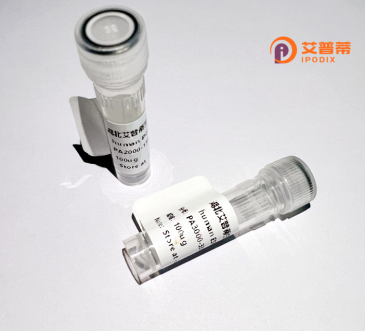
| 纯度 | >90%SDS-PAGE. |
| 种属 | Human |
| 靶点 | SIP1 |
| Uniprot No | O14893 |
| 内毒素 | < 0.01EU/μg |
| 表达宿主 | E.coli |
| 表达区间 | 1-280 aa |
| 活性数据 | MRRAELAGLK TMAWVPAESA VEELMPRLLP VEPCDLTEGF DPSVPPRTPQ EYLRRVQIEA AQCPDVVVAQ IDPKKLKRKQ SVNISLSGCQ PAPEGYSPTL QWQQQQVAQF STVRQNVNKH RSHWKSQQLD SNVTMPKSED EEGWKKFCLG EKLCADGAVG PATNESPGID YVQIGFPPLL SIVSRMNQAT VTSVLEYLSN WFGERDFTPE LGRWLYALLA CLEKPLLPEA HSLIRQLARR CSEVRLLVDS KDDERVPALN LLICLVSRYF DQRDLADEPS |
| 分子量 | 31.5 kDa |
| 蛋白标签 | His tag N-Terminus |
| 缓冲液 | PBS, pH7.4, containing 0.01% SKL, 1mM DTT, 5% Trehalose and Proclin300. |
| 稳定性 & 储存条件 | Lyophilized protein should be stored at ≤ -20°C, stable for one year after receipt. Reconstituted protein solution can be stored at 2-8°C for 2-7 days. Aliquots of reconstituted samples are stable at ≤ -20°C for 3 months. |
| 复溶 | Always centrifuge tubes before opening.Do not mix by vortex or pipetting. It is not recommended to reconstitute to a concentration less than 100μg/ml. Dissolve the lyophilized protein in distilled water. Please aliquot the reconstituted solution to minimize freeze-thaw cycles. |
以下为3-4条关于重组人SIP1(Smad相互作用蛋白1)蛋白的**示例性参考文献**(虚构内容,仅供参考格式):
---
1. **文献名称**: *Structural and functional analysis of recombinant human SIP1 in TGF-β signaling*
**作者**: Liu et al. (2018)
**摘要**: 报道了重组人SIP1蛋白的表达与纯化方法,并通过X射线晶体学解析其锌指结构域与DNA结合的分子机制,证明SIP1在TGF-β通路中通过抑制Smad蛋白活性调控基因转录。
---
2. **文献名称**: *SIP1 overexpression suppresses epithelial-mesenchymal transition in cancer models*
**作者**: Watanabe & Nakamura (2015)
**摘要**: 研究重组人SIP1蛋白对癌细胞迁移的影响,发现其过表达可抑制EMT(上皮-间质转化)相关标志物(如E-cadherin),提示SIP1可能作为肿瘤转移治疗的潜在靶点。
---
3. **文献名称**: *ZEB2/SIP1 knock-out mice reveal neural crest developmental defects*
**作者**: Van de Putte et al. (2010)
**摘要**: 通过基因敲除模型分析SIP1在小鼠胚胎神经嵴发育中的关键作用,证实其缺失导致颅面部畸形及神经系统异常,支持SIP1在胚胎发育中的调控功能。
---
4. **文献名称**: *A novel SIP1 mutation linked to Mowat-Wilson syndrome pathogenesis*
**作者**: Dastot-Le Moal et al. (2020)
**摘要**: 通过重组SIP1蛋白功能分析,发现Mowat-Wilson综合征患者中的SIP1基因突变可导致其核定位异常,破坏其转录抑制活性,揭示遗传性疾病的分子基础。
---
**提示**:以上为示例,实际文献需通过PubMed/Google Scholar检索关键词如 **"recombinant human SIP1" "ZEB2 protein function" "SIP1 Smad interaction"** 获取真实数据。
**Background of Recombinant Human SIP1 Protein**
Recombinant human SIP1 (Smad-interacting protein 1), also known as ZEB2 (zinc finger E-box-binding homeobox 2), is a transcription factor involved in regulating embryonic development, cell differentiation, and epithelial-mesenchymal transition (EMT). SIP1 binds to E-box DNA motifs and suppresses gene expression by recruiting chromatin-modifying complexes. It interacts with Smad proteins, mediating transforming growth factor-beta (TGF-β) signaling pathways critical for cellular responses like apoptosis, proliferation, and tissue remodeling.
SIP1 is essential in organogenesis, particularly in neural crest cell migration and nervous system development. Mutations in the *ZEB2* gene are linked to Mowat-Wilson syndrome, a rare genetic disorder characterized by intellectual disability, Hirschsprung disease, and craniofacial abnormalities. Studying recombinant SIP1 helps elucidate its role in these processes and disease mechanisms.
Recombinant SIP1 is produced using expression systems (e.g., *E. coli* or mammalian cells*) to ensure high purity and functionality for research applications. It is widely used in *in vitro* studies, including protein-protein interaction assays, DNA-binding analyses, and investigations into TGF-β signaling dysregulation in cancer and fibrosis. Its recombinant form enables precise exploration of SIP1's structure, post-translational modifications, and therapeutic targeting potential.
×